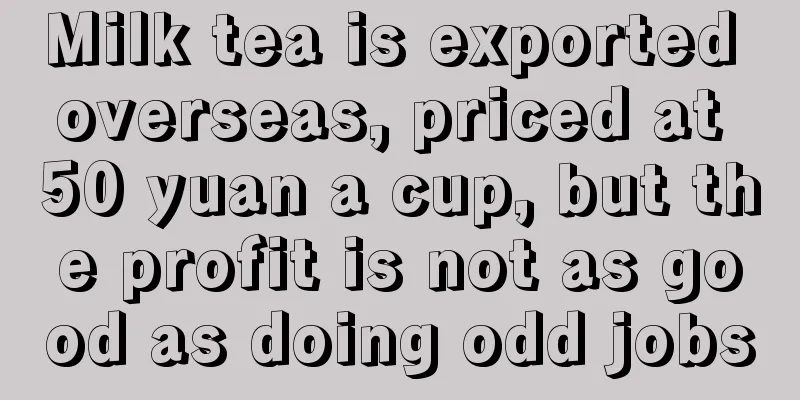Milk tea is exported overseas, priced at 50 yuan a cup, but the profit is not as good as doing odd jobs

“I left the country but it seemed like I hadn’t left.” Walking on the streets of London, New York or Paris, you can see familiar signs of milk tea shops and signs with the word "tea" in English from time to time. Milk tea shops that opened in county towns in China have turned around and opened in the bustling streets of first-tier cities overseas. They have captured Chinese wanderers and foreigners abroad with cups of sweet tea. Even Hillary and Bill Gates have started drinking milk tea. In China, tea brands have entered an era of stock competition, and even need to compete with affordable coffee brands such as Luckin Coffee and Kudi. Countless tea brands have begun to look for the next blue ocean, and have turned their attention to the overseas market, which has not yet been fully developed. Mixue Ice City has opened stores in the most prosperous areas of Sydney. The "Yidiandian" store in Los Angeles requires a queue of two to three hours. Heytea has opened an official account for the UK region and announced that it will arrive in London in mid-July. Milk tea going overseas is nothing new. At the end of the 20th century, pearl milk tea went abroad with Taiwanese compatriots to live and work overseas. Countless milk tea stalls and mom-and-pop shops have also taken root abroad. The overseas boom of tea brands in 2013 and 2018 has led many Asians to open milk tea shops and even create overseas tea chain brands. Overseas milk tea has also changed from powdered milk tea to freshly brewed tea, and all kinds of milk tea shops have blossomed overseas. "In 2018, milk tea still felt like a 'niche drink' and most of the customers in the store were Asian. In recent years, more and more local young people have come to buy milk tea." Guang Guang, who opened a milk tea shop in Paris, told us that milk tea is gradually becoming part of the lives of people abroad and has become another option besides coffee. Tea brands have gone overseas in groups, and countless overseas Chinese have opened milk tea shops in prosperous streets overseas. Early brands that went overseas explored the supply chain, and domestic merchants began to provide one-stop store opening services to overseas merchants, as well as online milk tea training classes, so that store owners can "learn to make milk tea at home." The cost of opening a store is gradually decreasing. It takes less than 80,000 yuan to purchase a set of milk tea shop equipment, and 40,000 US dollars to take over a second-hand milk tea shop. The overseas milk tea market is like California, the state of the United States, where gold was discovered 175 years ago, attracting countless gold diggers. More and more milk tea shops are opening in the same neighborhood, leading to a wave of closures and transfers. Even some landlords are reluctant to rent their houses to milk tea shops, fearing that they will go bankrupt in a few days due to poor management. For milk tea entrepreneurs who go overseas to seek gold, opening a milk tea shop is not an easy thing. The only one who can make a profit without loss may be the shovel seller behind the milk tea gold rush. 1. The “price war” that cannot be fought"A cup of milk tea can help me get rid of my homesick." Luo Luo, who is studying in London, joked that milk tea, which is available everywhere in China, has a different meaning for international students. There are more than 20 milk tea shops in London alone, including CoCo, Yifang Taiwan Fruit Tea, Happy Lemon, Chatime, machimachi, and many dessert shops and restaurants also have Chinese milk tea. Similar situations have also occurred in New York, USA, Paris, France and Toronto, Canada, where more and more people are drinking bubble tea. "In the 1980s and 1990s, many Taiwanese compatriots went to work and live overseas. Most of the people who opened milk tea shops overseas were also Taiwanese compatriots. The earliest product that appeared abroad was pearl milk tea, which was invented in Taiwan. In recent years, more and more mainland students, Chinese and Asians have started to open milk tea shops. The stores are getting bigger and bigger, and many domestic fruit teas and creative teas have also appeared." Daxiong, who opened a shop in New York, said that his shop was taken over from early Taiwanese immigrants. He works in New York, and the milk tea shop is his "side job." The earliest Taiwanese bubble milk tea completed overseas market education, and overseas milk tea followed closely and experienced different eras just like domestic milk tea. First, milk tea brewed with powdered creamer, then milk tea made with some tea base and fresh milk, and then creative new tea drinks made with high-quality tea, fresh milk and fruit ingredients, more professional milk tea shops gradually replaced the former husband-and-wife shops and street stalls. Compared with the domestic milk tea market where price wars are rampant, the price of milk tea overseas is almost 3-4 times that of domestic milk tea, and the price of some milk teas has even increased in recent years. Heytea, which keeps reducing prices in China, launched a poll on Xiaohongshu, asking people to guess how much a cup of succulent grapes costs abroad. The lowest price option is 7 pounds (about 65 yuan), while the prices of other milk tea shops in London are basically 4-7 pounds (about 37-65 yuan). The price of milk tea in various parts of the United States is 5-8 US dollars (about 35-50 yuan) a cup. This year, Mixue Bingcheng, which opened a store in Sydney, Australia, was highly anticipated. Many people wanted the "Snow King" to revamp the Sydney milk tea market. Unexpectedly, during the trial operation period, a cup of "Snow King" was 2-3 Australian dollars (about 9-15 yuan), and the price increased by about 80% a week later, which attracted complaints from international students, "I thought you were here to revamp the market, but I didn't expect you to join them." McDull, a partner of a milk tea shop in Australia, explained the reason: "Whether it is a franchise or not, foreign milk tea shops almost all follow the same model. Ingredients that are easy to preserve are purchased from domestic suppliers or shipped here, while those that are not easy to preserve are purchased locally. Purchasing from domestic suppliers or suppliers will be expensive once taxes and shipping costs are added. Fresh milk and fruits are purchased locally, and they are more expensive due to supply and seasonal reasons. Labor costs are also expensive overseas. Our store is basically part-time, but labor costs are still very high." Several other shop owners also said that labor costs have been rising. For example, the minimum hourly wage in Vancouver has increased from 14.6 Canadian dollars in 2020 to 16.75 Canadian dollars in 2023, and the hourly wage in Los Angeles has increased from 15 US dollars in 2021 to 16.78 US dollars. If the store is on the food delivery platform, it will be charged 30%-35%. "Price increases may not save the store. There are many people selling second-hand milk tea equipment in the Chinese community and real estate agents have a lot of information about the transfer of milk tea shops. A store that cost $100,000 to open can be transferred for only $40,000." 2. From earning 200,000 yuan a month to working part-time“When we first opened in 2016, we were the only milk tea shop within a three-kilometer radius. Now there are probably more than 20 milk tea shops in the city.” Ding Ding, who opened a milk tea shop in Florida, USA, has witnessed the entire development process of milk tea from a niche to a hot brand. 2010-2013 was the first peak period for milk tea to go overseas. Taiwanese tea brands represented by BoBoQ, Chun Shui Tang, CoCo and Gong Cha went overseas one after another. Around 2018, milk tea went overseas to usher in the second small peak, and countless tea brands and milk tea entrepreneurs set their sights on Southeast Asia. After the adjustment of the COVID-19 prevention and control policy last year, Mixue Bingcheng, Yidiandian and Heytea formed a group to open stores in Europe and the United States, and milk tea went overseas to usher in another small peak. "Opening a milk tea shop overseas, earning 200,000 yuan a month." Four or five years ago, many Chinese people had heard similar news, but such wealth myths are disappearing. "Five years ago, we were able to achieve a turnover of 200,000 yuan, of course in RMB. At that time, the net profit margin was 40%, and the net profit was 100,000 yuan a month." Dayi, who once opened a milk tea shop in California, USA, said that after the outbreak of the epidemic, the supply of raw materials was insufficient, shipping costs increased, and customer flow and orders also decreased significantly. His milk tea shop has been losing money for nearly half a year. After finally surviving, Dayi discovered that several milk tea shops had opened nearby. “In addition to independent stores, there are also chain brand milk tea shops. Our store is losing orders. Based on the minimum hourly wage, the money I make is not as much as if I worked in a milk tea shop.” Finally, Dayi chose to transfer the store. Ding Ding saw seven or eight milk tea shops opening around him, and also watched the milk tea shops around him go bankrupt one after another. "One shop that had been open for three years didn't make it." Ding Ding himself chose to close the shop in 2021. Li Jun, who runs a catering business in the UK, also said that some landlords are now unwilling to rent shops to independent milk tea shops. "The market is saturated, and landlords are also worried that they will go bankrupt and look for transfers within a few months." Tea shop chain brands are expanding their stores overseas, using brand effects to seize the market and gain more potential traffic. It is difficult for small independent players to grab a piece of the pie, and it is also difficult for them to join the chain players: joining requires strong capital. Requirements for partners on CoCo's official website CoCo's overseas franchise is mainly in the form of regional agency franchise. If you want to open a store, you need to have assets and a registered company overseas, and prepare millions of yuan of agency review funds. At the same time, franchisees need to set up a branch company with CoCo before opening a store, each contributing 1.5 million yuan, with franchisees holding 44% and the brand holding 51%. The brand is responsible for recruiting store managers, who need to hold 5% of the shares. Uncle J, who works in the catering business in the United States, said that he learned that it would cost more than $300,000 to join a milk tea shop, and it might even reach $500,000. "You can buy a restaurant for this price." Reni, who chose to open a franchise store, returned to China in 2020 and found an 18th-tier tea brand and obtained the overseas regional agency rights. At that time, it only cost 100,000 yuan, plus the cost of equipment and the first batch of materials did not exceed 350,000 yuan. "This brand has less than 100 stores in China. I want to save some trouble. It's too tiring to find equipment, materials and formulas by myself, so I just go to the brand and solve it all at once." Under his management, the initial investment cost was earned back in less than a year. With the development of the overseas milk tea market, the overseas agency rights of this tea brand have risen to 400,000 yuan, and the prices of equipment and materials are also rising. In addition to franchise fees, equipment fees and material fees, franchised milk tea shop owners also have to face expensive rent and decoration costs. Independent shop owners can decide the store location by themselves, choose a second-hand beverage store, and reopen the store after applying the previous renovation, but chain franchise brands basically require the store location, area and decoration, which will cost more. Da Xiong in New York also feels that the shops are becoming "involuted". "More people are drinking milk tea, but our business hasn't changed much. I've heard of many shops losing tens or even hundreds of thousands of RMB. Last year, the owner of a milk tea shop I knew asked me if I needed equipment, recipes, and raw materials. He didn't know what to do with these things after closing the shop. He couldn't bear to throw them away, and it would cost money to rent a warehouse." 3. Milk tea goes overseas, reproducing the story of the gold rush"You can make money from milk tea, but it's a gamble. The milk tea market in first-tier cities abroad is basically saturated, but there may still be opportunities in non-first-tier cities." Rainey said with emotion that when he first opened the store, he also experienced losses for nearly two months. It was not until he made several promotions among local international students and on social media that business slowly picked up. Many store owners interviewed also said that whether they are franchisees or independent store owners, there is uncertainty in making money. The ones who really make money are the merchants in the supply chain. In the craze of exporting milk tea overseas, they have achieved the goal of "sitting at home and making money from the sky." The first Taiwanese tea brand to do business in the supply chain and also the first to go overseas. BoBoQ, a Taiwanese brand that fired the first shot in the overseas expansion of milk tea, opened its first store in Berlin, Germany in 2010. By December 2012, it already had 106 overseas franchise stores. Now the brand has begun to move upstream and has become a supplier of raw materials for milk tea produced in Taiwan. When opening a store, Guangguang from Paris consulted a company called possmei. The company’s headquarters is also in Taiwan. It provides store consultation, brand design, decoration design, and raw material supply services. It has agents in Germany and the United States. “They do the whole store export business, and all you have to do is pay the money.” In addition to equipment suppliers and whole-store export service providers, there are also many milk tea raw material suppliers in Europe and the United States. The raw materials of a European milk tea raw material supplier are about 20% cheaper than those of local stores, and the net profit can reach 15%-30%. The goods can basically arrive in Europe within a week. "We have a warehouse in Europe, and some small equipment and milk tea formulas for sale. We also have the raw materials for the popular snowflake ice in China this year." Many shop owners who opened stores early on also began to target upstream businesses. After closing the store, Ding Ding started doing milk tea shop consulting and training. "To be honest, it's much easier than opening a store before." In addition to merchants who use supply chains to do milk tea business overseas, domestic supply chain merchants have also started the milk tea export business. Guangdong has tea brands such as Nayuki's Tea and Heytea, and has developed industrial and foreign trade industries. Many businesses engaged in the export of milk tea equipment and raw materials are doing business in Guangdong. Chen Ke, who is engaged in the export of milk tea equipment in Guangzhou, is in the business of exporting whole stores. In the price list he sent, a full set of milk tea shop equipment including double-sink worktops, refrigerated flat cabinets and split ice makers, the cheapest one is less than 60,000 yuan, "with EU CE certification, European standard plug, and shipping to Europe is more than 10,000 yuan, and the whole set is less than 80,000 yuan. We also have better quality ones, but they are more expensive. We also have online tea training, and classes can be taken overseas." Compared with other people who are looking for opportunities in the milk tea export boom, suppliers who hold raw materials and equipment do not need to "move" much. A promotional blog post on a social platform can attract a large number of inquiries and purchases. Compared with milk tea, which has almost no technical barriers, the technical threshold of hardware equipment vendors, the time cost and resources invested by service providers in research and R&D, naturally form a competitive barrier. "I'm not pessimistic, but in the end, the overseas milk tea market will probably become the same as the domestic one, with chain brands becoming the mainstream, and mom-and-pop stores and independent milk tea shops slowly disappearing." Rainey is planning to use his agency rights to franchise in surrounding cities. He doesn't plan to charge too high a franchise fee, but wants to expand the business first - providing equipment and materials to franchisees, which will earn him more than the franchise fee. The gold rush of milk tea export seems to be repeating the story of the gold rush in the United States. Gold mines were discovered in California, and countless gold diggers from the United States, Europe, South America and China came to seek wealth, causing the population of California to soar by more than 10 times. The gold prospectors may not have gained anything, but the shovel sellers and water sellers in the gold rush made a lot of money. Finally, businessmen, workers and entrepreneurs set up mining companies and gradually controlled the mining areas. Professional large-scale mining companies eliminated individual gold prospectors and made gold mining a more organized industry. In 2010, BoBoQ milk tea launched its first overseas expansion. 13 years later, tea chain brands with successful business experience and stable supply chains have emerged in the overseas market. These are the "mining companies" in many gold rush stories. It may only be a matter of time before these mining companies replace individual gold diggers. Author: Wang Zhan Source: WeChat public account "E-commerce Online" |
<<: [Breakthrough] Is there a way to delete friends in batches on WeChat?
>>: After understanding the private domain, do the private domain
Recommend
618: Short dramas promoting products, a new battlefield between Alibaba and Pinduoduo
This article mainly discusses the phenomenon of e-...
My minimalist information management method
Information needs to be managed because it is high...
[Revealing] How do top bosses attract fans with their personal stories?
We often see some top bosses share some exciting a...
I deleted all the content, so the data increased?
How can designers optimize copywriting and interfa...
How do I log in to the Chinese version of gmarket? What is the shopping process?
Gmarket is actually a Korean e-commerce website. W...
What is the Amazon Trademark Registration Number? What is going on?
Dear Amazon merchants, if you want to upload brand...
What is the Amazon FBA shipping process? Newbies must learn the shipping process
Amazon merchants need to solve logistics problems ...
The four-step product selection method that ordinary people must learn to start an e-commerce business. I personally practiced and summarized the refined version
In this article, the author shares a product selec...
What are the techniques for Wish to boost sales? What should you know?
The Wish platform is a cross-border e-commerce pla...
5 user analysis rules used by major Internet companies!
Many companies need to analyze their users, but ho...
How many days will Amazon be closed for Chinese New Year? How to ship during holidays?
During the Chinese New Year, many e-commerce platf...
Can Amazon SKU be modified? What are the methods to modify it?
After we open a store on Amazon, we need to upload...
To get the best deal on Meituan, buying a membership is the worst option
In order to eat cheaper or buy cheaper, many consu...
Do data analysis like this and operations quarrels will be reduced by half
Operational work and data analysis are closely rel...
100,000 people watched the auction. How did Sprite, which was founded in 1982, use old tricks to create new growth on Douyin?
The once popular online meme "Sprite in 1982&...









